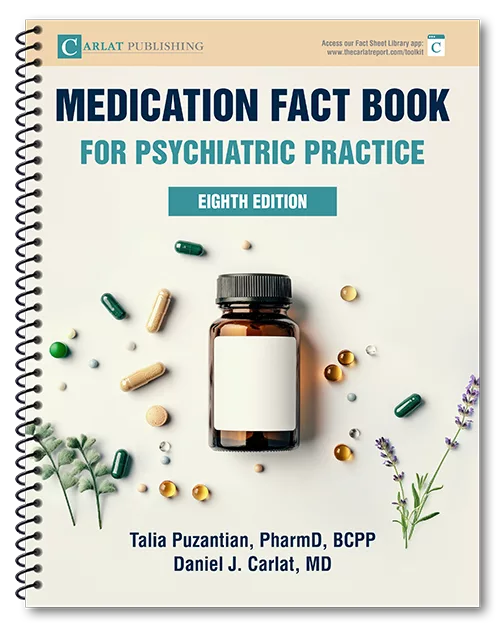Generic Lurasidone Shifts the Balance in Bipolar Depression
Chris Aiken, MD. Editor-in-Chief, The Carlat Psychiatry Report. Assistant Professor, NYU Langone Department of Psychiatry. Practicing psychiatrist, Winston-Salem, NC.
Dr. Aiken has no financial relationships with companies related to this material.
Lurasidone was heralded as a game changer when it first gained FDA approval for bipolar depression in 2013. In 2023, it went generic, and in this article, I’ll look at what that means for patients with bipolar disorder and schizophrenia who can now afford its $10–$20/month cost.
Lurasidone in bipolar disorder
It may seem like every antipsychotic treats depression, but this is not the case. Only five are FDA approved in bipolar depression, and they are the only five that are known to work, listed here with their optimal doses for bipolar depression: cariprazine (Vraylar, 1.5 mg QD), lumateperone (Caplyta, 42 mg QHS), lurasidone (Latuda, 20–120 mg QD with a full meal), olanzapine-fluoxetine combination (Symbyax, 6–12 mg olanzapine with 25–50 mg fluoxetine QHS), and quetiapine (Seroquel, 300 mg QHS).
Up until recently, there was a glaring disparity between the tolerability of the cost-effective older medications and the newer, branded options. Sedation and weight gain are much higher with olanzapine-fluoxetine and quetiapine, so lurasidone’s patent expiration brings a better-tolerated option within reach.
Lurasidone’s efficacy in bipolar depression compares favorably with its antipsychotic competitors. Almost all of them have a number needed to treat (NNT) around 4, which is average for psychiatric medications. (Cariprazine is the exception, with a weaker NNT of 11.) Quetiapine stands out for its anxiolytic benefits, which were demonstrated in a large, placebo-controlled trial of bipolar disorder with comorbid generalized anxiety. Lurasidone is promising there, but has only showed anxiolytic effects indirectly, through secondary analyses of other trials (Goldberg JF et al, J Clin Psychiatry 2023;84(4):22m14732).
Where lurasidone does rise to the top is in cognition and major depression with mixed features. It is the only antipsychotic with evidence of improving cognition in bipolar disorder, which it demonstrated in an RCT of stable (euthymic) bipolar patients who had cognitive complaints. Later, it outperformed quetiapine on cognitive measures in a head-to-head trial of bipolar depression (Diao X et al, Pharmaceuticals (Basel) 2022;15(11):1403).
Lurasidone is also effective in unipolar major depression with mixed features, where patients have at least three manic symptoms during depression but do not qualify for a bipolar diagnosis.Lurasidone has the most robust data in this population; lumateperone is a close second (Suppes T et al, Am J Psychiatry 2016;173(4):400–407).
One thing that stands out for lurasidone is its wide dose range, with benefits that are noticeable at 20 mg/day, peak around 40–60 mg/day. For the others, the depressive benefits are restricted to the lower ranges, with antimanic effects in the higher range.
Lurasidone, however, has never been tested in bipolar mania. This makes it a poor choice for monotherapy in bipolar I disorder, but fortunately it does have studies confirming it can treat depression as an augmentation to lithium or valproate. Whether lurasidone prevents future episodes of bipolar depression is an unsettled matter.The only controlled preventative trial was brief (six months) and failed to reach statistical significance (Calabrese JR et al, Eur Neuropsychopharmacol 2017;27(9):865–876). I recommend continuing lurasidone for 6–12 months after resolution of bipolar depression, at which point a slow taper (over 1–2 months) is optional.
Mechanism in depression
Antipsychotic medications block dopamine (D2), which is actually a liability when it comes to depression. Too much dopamine blockade can cause depression directly, or indirectly mimic it through side effects like emotional flattening or cognitive or motoric slowing. This is a particular problem with the first-generation antipsychotics, and can also be seen with the newer generation if the dose goes too high.
Exactly how the antipsychotics treat depression is not well understood and probably differs for each agent. For lurasidone and lumateperone, serotonin antagonism is thought to be responsible (at the 5-HT7 and 5-HR2A receptors, respectively). Cariprazine enhances dopamine transmission at the D3 receptor that regulates hedonic drive. Olanzapine is the only member of the group that requires an antidepressant (fluoxetine) to work. Quetiapine may lean on a similar crutch, as it is converted into an active metabolite (norquetiapine) that functions like a serotonin/norepinephrine reuptake inhibitor (SNRI) antidepressant.
Lurasidone in schizophrenia
Lurasidone does not bring greater efficacy in schizophrenia, where clozapine is the only antipsychotic that truly stands above the rest. Among the other options, olanzapine and risperidone offer slight advantages for positive symptoms, while aripiprazole and cariprazine have a slight edge for negative symptoms. The rest are middle-of-the-road for efficacy. Lurasidone’s main advantage in schizophrenia is tolerability, which is comparable in most respects to that of the branded options brexpiprazole (Rexulti) and cariprazine (Vraylar) (Phalguni A et al, Int Clin Psychopharmacol 2023;38(1):45–56).
Only one antipsychotic, paliperidone (Invega), has FDA approval in schizoaffective disorder. Lurasidone lacks direct studies in this population, but patients with schizoaffective disorder were included in some of its schizophrenia trials (McEvoy JP et al, J Clin Psychiatry 2013;74(2):170–179). Lurasidone is better suited for the depressed phase of schizoaffective disorder and less ideal for those with prominent mania.
Tolerability
Lurasidone’s main advantage is its low risk of metabolic side effects, which were similar to placebo in studies lasting up to six months. However, there was a signal of greater weight gain at higher doses (>40 mg/day). Anticholinergic side effects, hyperprolactinemia, orthostasis, and QT prolongation are possible but less common on lurasidone than others in this class.
Its main risks are side effects that cause early discontinuation: nausea, akathisia, and somnolence. The akathisia risk is higher than other antipsychotics and rises sharply as the dose goes higher (Wu H et al, Eur Neuropsychopharmacol 2023;72:40–49). Raising the dose slowly and treating with propranolol or a benzodiazepine reduce this risk.
Carlat Verdict: Lurasidone brings greater tolerability to the generic options for bipolar depression, although its efficacy advantage is limited to the cognitive symptoms of bipolar disorder. Drawbacks include a high risk of akathisia, lack of known antimanic effects, and the need to take it with a full meal.

Newsletters
Please see our Terms and Conditions, Privacy Policy, Subscription Agreement, Use of Cookies, and Hardware/Software Requirements to view our website.
© 2025 Carlat Publishing, LLC and Affiliates, All Rights Reserved.



_-The-Breakthrough-Antipsychotic-That-Could-Change-Everything.webp?t=1729528747)



